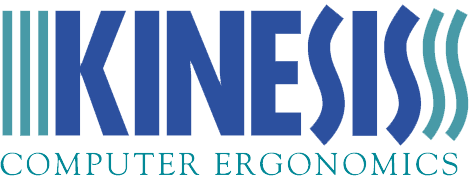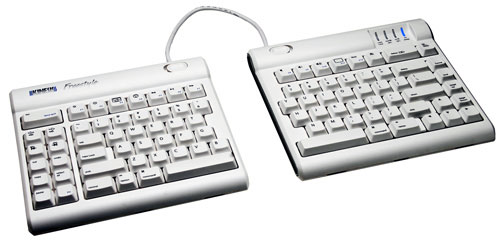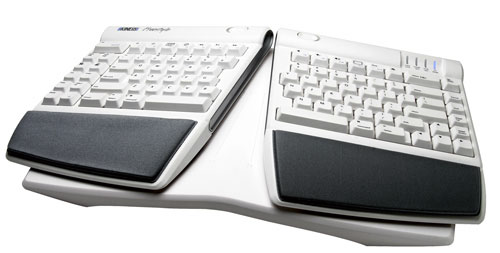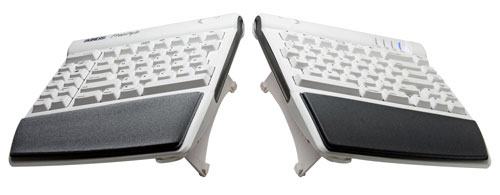A discussion on the Kinesis
FREESTYLE CONVERTIBLE ERGONOMIC SPLIT KEYBOARD
http://www.kinesis.com/

MYMAC: What does ergono mic really mean, with respect to continuous or occasional keyboard typing and arm/hand placement?
KINESIS: Ergonomics is the study of the relationship between people and their working environment. The science of ergonomics is devoted to maximizing human performance without causing injuries and increasing comfort and productivity.
Keyboard ergonomics attempts to reduce awkward postures, excess force, and unnecessary repetition, while at the same time maintaining or improving productivity. This is not an easy task with keyboards, because typing is a complex and physically-demanding skill. Any changes require tradeoffs, and can have ineffective or unintended consequences.
It is well known that traditional keyboards create several awkward postures which in turn can encourage excessive force. These awkward postures include ulnar deviation (hands bent outwardly at the wrist, constraining nerves and ligaments), pronation (palms horizontal, creating tense forearm muscles), wrist extension (hands bent upward that the wrist, also constraining nerves and ligaments), and over-reach for pointing devices. With many typists these cause discomfort and decreased productivity. In some intensive computer users, these lead to injuries which can be permanent and disabling.
A good ergonomic keyboard should be designed to reduce or eliminate awkward postures and excessive force, which should result in increased comfort. A great ergonomic keyboard should also reduce unnecessary repetition and increase productivity.
As an example of design tradeoffs and unintended consequences, the widely-known Microsoft Natural-style keyboard is splayed at a fixed angle to reduce ulnar deviation and is moderately “tented” (elevated center) to reduce pronation. However, the degree of splay doesn’t fit all users and requires substantial adaptation for productive typing, while shifting some strain from the wrists to the neck and shoulders. Even more importantly, the reach for the mouse is increased for right-handers compared to a traditional keyboard, which is not a desirable outcome.

MYMAC: Is the separation feature in your Freestyle keyboard actually useful, or is it some sort of gimmick?
KINESIS: The separation feature is certainly not a gimmick, but satisfies well-established ergonomic principles. For most users, complete separation is actually easier to adapt to than the “splay” geometry of Microsoft’s “Natural-style” keyboard, and is more comfortable as well.
Early in the design process we met with ergonomists, occupational therapists and other health/safety professionals. We queried them as to what features of existing ergonomic keyboards are important to them as well as what features they would like to see that weren’t currently offered. An overwhelmingly response was that they wanted a keyboard that had left and right modules that could completely separate from each other.
They argued that fixed-split keyboards such as the Microsoft Natural as well as other keyboards that had variable splay could not accommodate for the extreme variability in shoulder widths and body types. By having a completely separable keyboard each user can adjust the separation to accommodate their shoulder widths, thereby, placing them in a relaxed and neutral position.
MYMAC: How important are your padded wrist supports for most Freestylers?
KINESIS: Our supports actually support the palms rather than the wrists, because resting on the wrists can compress the carpal tunnel and cause blood flow and nerve problems. Palm supports greatly reduce wrist extension, which is an important cause of discomfort and a risk factor for injury.
All but the most-disciplined typists rest their palms or wrists on whatever surface is convenient, and without integral wrist supports that would be either the work surface (or even the sharp edge of the work surface). When the keyboard modules are tented, the potential for wrist extension is even greater unless palm supports are integrated and tent with the keyboard.
MYMAC: How easy/difficult and expensive/affordable is it to replace those pads? How long will it take for them to wear out or become really disgusting?
KINESIS: The palm pads are self adhesive and can be easily removed without leaving any adhesive residue. They are available directly from Kinesis or any of our dealers for $12 per set. The useful life of palm pads is a personal preference but the comfort benefits are very long lasting. Changing them for appearance reasons isn’t likely to be desired more often than once a year for most users.
MYMAC: How easy or difficult is it to type on your Freestyle’s keys? Are there any important attributes of your keys we should know about in advance?
KINESIS: This is a great question and a very important aspect that users need to consider when evaluating ergonomic keyboards. We devoted extensive effort to developing a low-force yet tactile key switch. Most traditional keyboards including Microsoft’s latest ergonomic keyboard utilize key switches with an activation force of approximately 60 grams.
Because keyboarding is an intensely repetitive task, any reduction key force can improve comfort and reduce the likelihood of injury. We were able to design a key switch for the Freestyle with a key activation force of ~45 grams, approximately 25% less than most other keyboards. The key switch is also very quiet which helps make it popular in an office environment.
MYMAC: How did you decide which special keys to include, or exclude, for your new Mac Freestyle keyboard? What’s missing? How has the Mac community responded to your particular key placement?
KINESIS: The main objective was to provide the new features of the latest Apple iMac keyboard, plus additional features that were uniquely possible with the Freestyle keyboard and which we thought would improve productivity by reduce awkward postures and unnecessary repetition in “universal” tasks. Another important objective was to avoid the need for any special driver.
Thus unique left-hand hot keys were created such as “Web forward” and “Web back” (to reduce mouse clicking), plus “Cut,” “Copy,” “Paste,” “Select all,” and “Undo” (to reduce awkward key combinations). Most of the special top-row special legends emulate the new Apple iMac keyboard, but we felt some additional unique legended actions (Exposé action for “Show desktop,” plus “Show/hide dock,” and “Shutdown/sleep menu”) would be generally useful and appreciated by OS X users.
MYMAC: Do Mac users need any special software to use this keyboard?
KINESIS: No drivers or software are required. OS X 10.4 or newer is required to use the special actions on the F3, F4 & F11 function keys and the hot keys for F5-F7 require the Apple keyboard update 1.1 or newer.
MYMAC: Was Freestyle designed with any particular mouse, trackpad, or number keypad in mind?
KINESIS: We did not design the Freestyle with any specific pointing device in mind, though we did eliminate the number keypad in order to reduce over-reach issues for any mouse with right hander’s. Some users find it convenient to place a touchpad or trackball between the two split keying modules, but most users prefer a conventional mouse used in the normal (but closer, more comfortable) location. We also offer a separate Mac numeric keypad with USB hub for those who need it.
MYMAC: Who are your competitors in this specialized product category, and why should our readers favor Kinesis over other similar keyboards and companies?
KINESIS: There are several manufacturers of ergonomic keyboards with Microsoft being the largest. We feel that the Freestyle product family is the best in class by providing a flexible set of ergonomic features which can be tailored to each individual’s unique needs. We also offer a 60 day money-back guarantee on all of our products and a two year warranty on keyboards.
MYMAC: Tell us about your web video tutorials, and how they are much more useful for setup than the included printed instructions.
KINESIS: We designed these products to be easy to assemble and use, but almost everyone benefits from watching a video for the first time. The instructional videos located on the Freestyle pages of our website show how to attach and use the Freestyle accessories. They are a valuable supplement to the user guide that comes with each product.
Other videos on our web site detail the wide array of ergonomic features of the Freestyle keyboard. We encourage all of our customers to view these short but highly informative videos.
MYMAC: At what point should computer users seriously consider their desks, work stations, keyboard placement, chairs, and other physical equipment, relative to their choice of keyboard?
KINESIS: No component of your computer work station should be overlooked, but some changes are more likely to provide significant and immediate improvement in comfort and productivity. Most people already have an adjustable ergonomic chair, but an adjustable keyboard/mouse tray (and a foot rest for many) are also very important.
The keyboard and mouse should be included in the “first tier” of workstation components to assess because these two devices are used intensively and repetitively to interface with the computer. Once you have this basic set of ergonomic tools, it is important to adjust them appropriately to maintain neutral postures in order to get the most benefit.
MYMAC: What keyboard and mouse are you using to type your responses to our questions, and why?
KINESIS: I type on the Kinesis Advantage Contoured keyboard, which like the Freestyle has separated keying modules but provides more aggressive changes to arrangement of keys to provide the utmost in comfort and productivity. I’ve been typing on it since I started with the company back in 1996. However, the Contoured keyboard does require an adaptation period of at least several days, which for most computer users is not an option.
Because of its non-linear shape it is also more expensive to produce (thus a selling price approaching $300). Therefore, among our design objectives for the Freestyle was to create an ergonomically advanced keyboard with very little, if any adaptation time and priced under $100.
MYMAC: How do companies and businesses treat employees who request or require Freestyle or other unusual ergonomic keyboards?
KINESIS: Kinesis pioneered ergonomic keyboards in the U.S. with the introduction of the Contoured model in 1992, though Apple introduced its own adjustable keyboard design in early 1993. Back in those days, most computer workers had to pay for ergonomic keyboards out of their own pockets, and they cost a lot more than they do today. Many employers discouraged their widespread use, either for fear of admitting liability for the growing number of computer related injuries, or in hopes of avoiding the perceived cost of the “Sally got one, so I want one too” phenomenon.
Fortunately those days are now ancient history. During the Dot-Com boom (prior to the Freestyle), many startups and incubator companies were actually buying the Kinesis Contoured keyboard for all their programmers because it provided a morale boost and a competitive advantage in productivity. Today most large companies have pro-active ergonomics programs to identify and fix potential computer overuse problems before they become serious.
The down-side of this “ergo-as-needed” approach is that it associates the need for and benefits from ergonomic keyboards with a small percentage of computer users. However, significant bottom-line benefits can be gained with widespread deployment, if a company chooses wisely.
A few of the most forward-thinking companies do provide an ergonomic keyboard for every computer user. As it becomes easier to choose an effective design and the competitive advantage these companies experience becomes more visible, widespread deployment of ergonomic keyboards should spread in the future.
MYMAC: What sort of tech support do you offer during setup or follow-up?
KINESIS: We provide detailed printed instructions for all of our Freestyle products, and these include links to the online videos for supplement guidance. For technical questions or issues we provide free technical support by email or by phone for the life of the product.
MYMAC: Should people buy directly from your online store, or via another retailer? What warranty do you offer? Can buyers return a Freestyle if they decide it’s not a worthwhile keyboard? Are there places to get this keyboard outside of the Unites States?
KINESIS: Customers have the choice of purchasing directly from Kinesis or from one our many ergonomic dealers. Kinesis provides a two-year limited warranty on all keyboards. Post-warranty repairs are often cost-effective as well, so a customer can expect to enjoy many years of productive use. For purchases direct from Kinesis we offer a 60-day money-back guarantee less shipping and handling. Return policies differ among our dealers so customers should inquire as to their specific return policy. Prospective customers can contact us directly at 800-454-6374 or sales@kinesis.com to make a purchase or locate a dealer in their area.
Currently the Freestyle keyboard for Macintosh is only available in the U.S. layout. However, we support a growing network of dealers abroad where localized Freestyle for PC and other Kinesis products are available, including the UK, the Netherlands, Sweden, Germany, Japan, and Hong Kong.
MYMAC: Explain the pricing and ordering options for your Freestyle keyboard. Are the components a la carte, or bundled together for cost savings?
KINESIS: The idea behind the Freestyle was to create modular family of products that allowed users to purchase only the features they need, but to easily change the configuration later if desired. This design principle offers several benefits. First, price savings are possible because users are not paying for features they don’t want. A company can standardize on one keyboard layout, yet effectively meet the needs of a diverse employee group. Modularity also allowed us to design each accessory to provide simple, sturdy, and reproducible adjustments, providing better performance than products which try to offer a complete array of features in a single product.

For the Mac we offer the Freestyle Solo keyboard plus two accessory kits: the Freestyle Incline and the Freestyle VIP. Each accessory enhances the core feature set of the Freestyle Solo keyboard and attaches easily to its underside. The Incline provides for a sturdy fixed slope of 10 degrees and variable (but lockable) splay, emulating an “adjustable Microsoft Natural” keyboard. The VIP kit provides adjustable slope (10 and 15 degrees) and complete separation. Both accessory kits include sturdy, clip-on palm supports with soft, fabric-covered replaceable pads.

MYMAC: Are any special holiday or year-end pricing available?
KINESIS: For orders placed before the end of the year at our online store, we are offering a holiday coupon discount of 10% off any new Kinesis keyboard and Freestyle accessory.
email – MyMac Magazine – Twitter – Advertise – Reviews Archive – Podcast

Leave a Reply
You must be logged in to post a comment.